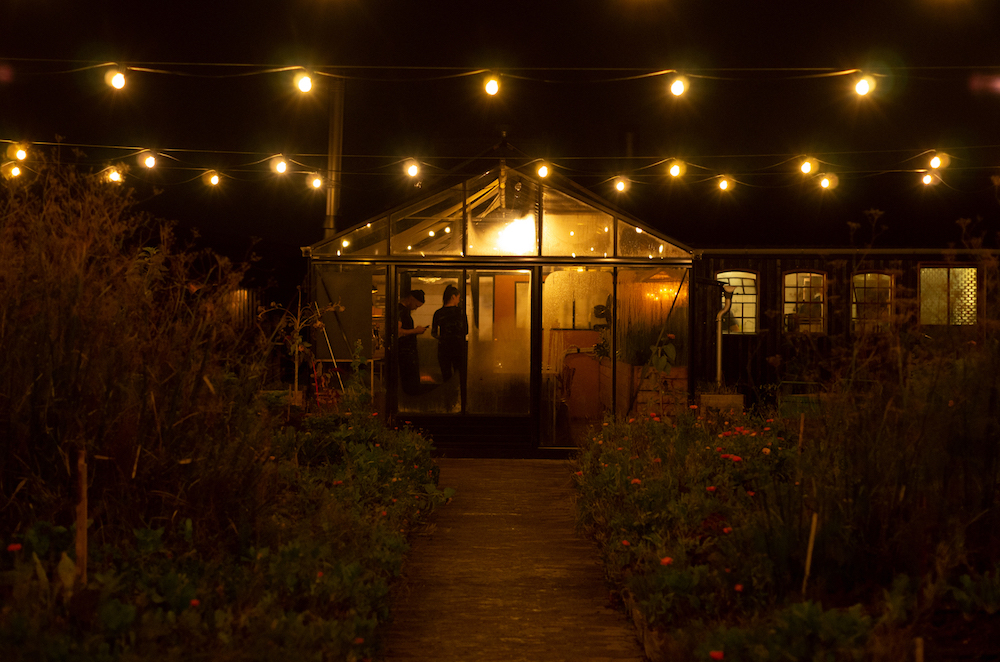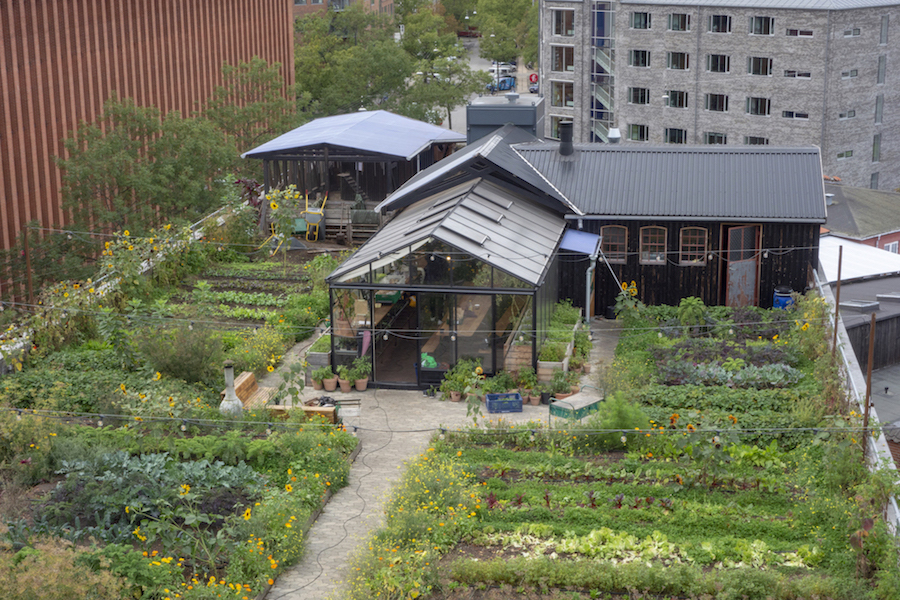遡ること1926年、近代建築の巨匠 ル・コルビュジエは、自身のマニフェスト「近代建築の五原則」の中で、“都市建築によって浸食された自然は、その建物の屋上で再構築されるべきだ” と述べた。
当時彼が考えていたのは、近代建築の中で最も重要な素材であるコンクリートを、住居者が太陽の下で余暇を過ごすための、ごく一般的なハウスガーデンで埋め尽くすことだった。昨今では、畑やスーパーマーケットから食卓へと食料が運ばれる距離が、だんだん遠くなってきている。そんな中、屋上というスペースを食物を生産する場所として利用することは、理にかなっているかもしれない。
コペンハーゲンのウスタブロ地区(Østerbro)の外れ、街の中心部からは自転車でおよそ20分ほどの所にある4階建のビルの屋上に、ØsterGRO(ウスタコ)は畑とレストランを構えている。屋上に辿り着くための螺旋階段は、そこまでの高さではないものの、登っていくうちに軽い不安を感じた。

屋上にたどり着くと、創始者のうちの一人であるクリスチャンが、ボランティアスタッフのうちの一人とテーブルを作っている最中だったが、快く出迎えてくれた。

その日は9月の日中。デンマークの典型的な気候、冷んやりと冷たい曇り空の中で、5人ほどのスタッフが畑で農作業をしていた。

畑には野生の雑草に囲まれた、花やキャベツ、トマトなどが育っていた。その反対側には、小さな木製の家に作り足された温室の中で座っている人達が見える。外から様子を伺っていると、温室の中にいた一人が、“中へ入りなよ”、と笑顔で招き入れてくれた。
中に入ると、グリルされたチーズやトマトにパスタ、クリームなどの濃厚な香りが充満していて、ちょうどラザニアが提供されるところだった。気がつくと長いテーブルは満席になっていた。さらにヴェジタリアンのラザニアに、肉料理が一種提供された。
長いテーブルを囲み、周辺に座っている人達とラザニアをシェアしながら団欒をしていた。偶然隣り合わせたのは、数分遅れて到着した、創始者のうちの一人であるリビアだった。リビアはØsterGROの生い立ちについて話してくれた。
オフィスビルやマンション、工事現場に囲まれて立っているこのコンクリートの建物は、かつては車のオークションのために使われていた場所だったそう。そのため、天井は車の積み荷による重量を支えられるように設計され、どんな大きさの車でも運搬できるよう、大きなエレベーターが設置されていた。そのおかげで、何トンもの土を容易に屋上まで運べたようだ。元々のビルのオーナーは、“何かしら自然にとって良いこと”、“街の持続可能な発展に貢献するビジョンを持った入居者” にビルのスペースを貸したいという思いもあり、ØsterGROの “農業プロジェクト” が、この空間を得ることは難しいことではなかったようだ。さらにコペンハーゲン市と、とある有機農業を支援する基金の助けにより、2014年にこのプロジェクトは始動できたそう。
ØsterGROの主な目的と原動力の一つは「サステナビリティ」。目標は、曖昧であるこの言葉を具体的なかたちを持ったものにすること。「サステナビリティ」のラベルが貼ってある食品を消費するだけではなく、人々が実際に訪れ参加できる空間づくりを目指しているそう。
種が植物に変わり、有機廃棄物となった植物がたい肥となり、次に芽を出す植物のために使われるという農作業のプロセスを通して、循環性といった概念について理解をすること。

すべてはコペンハーゲンのとあるビルの屋上で行われている。この屋上の畑を土で埋めるため、100人近くの周辺の住人やボランティアで携わる人から創始者まで集まって、週末がかりで完成させた。
そんな話をしながら食事を終え、自分たちでお皿をキッチンまで運んでいった。キッチンは意外と大きく素敵で、街中の雰囲気とは全くの別空間だった。
比較的小さな街であるコペンハーゲンでは、使用可能な屋上のスペースを全て利用したとしても、自給自足できるほどの野菜を育てることは難しい。「一番の目標は、ここに来る人たちのなかに問題意識の種をまくこと、特に近所の方々やその友人、それから結婚式や会社のイベントの際に、家族や友人に連れられてここにやってくる人々に「ØsterGRO」という空間でいったいなにが起こっているのだろうか?ということに興味を持ってもらうことなんです」。
リビアは続けた。「ここに来る人の中には、有機農業やサスティナビリティなんて、都市人間がでっちあげた左寄り(政治的)な思い上がりだ、と思っている人達もいます。しかしここで私たちの活動について知り、自ら農業に携わっていくうちに、農作物を育てている人の大変さについて全く新しい視点を得て、その作業の裏側や周辺に渦巻く過程を学ぶことにより、少しでも関心を持ってもらえればと思っています」。
つまりは、実際に体験することによって、エコシステムを身近に感じることができるということだ。
大勢の人達の協力がなければ、「ØsterGRO」はここまで来れたなかった。“一人で闘ってきた若い女性起業家” といえば聞こえがいいかもしれないが、リビアは本当にそうではないのだと、共に活動してくれた人々のおかげなんだと、慎ましくも強調した。
地元のジャーナリストがリビアについて話すとき、「一人でやってのけた、若くたくましい女性起業家」という表現をよく使うそうだが、リビア自身はきっぱりと、そうではないし、そう描写してほしくもないと強調していた。
現在「ØsterGRO」は主に3つの要素によって構成されている。クリスチャンとリビアを含む屋上農業を運営する者、ボランティアのメンバー、レストランに野菜を提供する農家の方々だ。
毎週水曜日に、ボランティアのメンバーが畑で農作業をするために集まるのだそう。これは地元の有機農家で作られた野菜を詰め込んだバッグの配給がある日でもある。
「ØsterGRO」では他にも、植物の受粉やハチミツを採取するために蜂を育てたり、畑で取れた野菜から種を集めたりもしている。時には珍しい野菜を広めたいがために、自身の庭から取れた種を持って訪れる人もいるそうだ。それ以外には、日本も含めあらゆるところから種を分けてもらっているそうだ。そのおかげで「ØsterGRO」は多様性に富み、毎年クリスマスシーズンになるとマーケットを開き、そのうちのいくつかの種を販売しているという。「ØsterGRO」で採れたハチミツと、彼らが協力している他の農家でできた野菜は、ボランティアに携わる人達の間でのみシェアしているそうだ。

数年前に「ØsterGRO」のメンバーによって建てられた屋上のメインハウスの外面に使われているのは焼かれた唐松で、北欧では珍しいものの、木材の保持または含浸という目的のためにはとても効果的だという。

「何年か前に、とあるシェフの団体が私たちのスペースを借りて、雄々しく「自分」を中心とした物語に重点を置いた料理を作り提供していました。彼ら自身の描写の仕方があまりにも “ØsterGROの理念” からかけ離れていたため、評判の良さや質の高さに関わらず、契約を切ることにしました」。
現在のキッチンを運営するチームは、「ØsterGRO」のプロジェクトに賛同したシェフ達によって成り立っている。週に4、5回、2つのコミュニティテーブルを囲んで食事をするスタイルの、彼らの一番の目的は、「活動の物語を語り広めていくこと」。料理に使われている全ての食材が、この小さな屋上の畑で収穫されたものではないということも、レストランにとって重要なポイントだ。そんなことはこの小さなファームではほぼ不可能。客として来てくれる人々が、ここの畑で何が育っているかということだけではなく、「最終的にお皿に乗る食べものを育てることの大変さ」を理解してもらうことが、とても大切なポイントなのだ。
彼女たちのプロジェクトは、その屋上で起こっていることだけに留まらず、近隣の住人から遠方や近辺から訪れる人、たまたまやって来た人達も含め、そこに参加する全ての人達が、世界的に広がっていくムーブメントの一部となっている。そのムーブメントは、力強くもローカルの人々に強いインパクトを与え、近代建築という概念に積極的に取り組み、わずかな街の一部を緑にしている。それだけではなく、彼女たちは、市民に何かしら食について考えるきっかけを与えているのだ。

—
All photo by Markus Oxelman
—
Markus Oxelman & Natsuko Natsuyama
2017年、コペンハーゲンでたまたま同じシェアアパートに住んでいたMarkusとNatsukoは、色んな国を行き来するライフスタイル、食やワイン、アートや音楽の趣味が近かったため、すぐに意気投合し多くの時間を共有し始めた。2018年には数ヶ月共にジョージアに滞在した。現在は両者共、コペンハーゲン、東京を行き来しながら、コペンハーゲンやジョージアにまつわる記事を執筆している。
Instagram:
Markus
Natsuko
Georgia
Back in 1926, Le Corbusier stated in his manifesto ”Five Points Towards a new Architecture” that the green space that a building in the city ”eats” should be re-established on the roof as a compensation. Him at the time mostly having his thoughts on a space that would represent a more usual house-garden, for inhabitants use of spending leisure time under the sun, and compensating to all the concrete that would be one of the most important materials in modernist architecture. Surely though, rooftops are one of the spaces in the city that we could consider for growing edibles, as we see an expanding distance from farm (to supermarket) to table.
The rooftop farm ØsterGRO is located in the outer part of Østerbro in Copenhagen, about a 20 minutes bike ride from the centre in a recently renovated building where the three indoor stories are used as office space. Although the rooftop is not more than four stories up, the exterior spiral staircase sets out a bit of discomfort as I ascend.
When I arrive at the rooftop, some four stories up, I’m welcomed by Kristian who one of the founders, who is building a table together with one of the volunteers.
Even though it is a grey, cold, September Wednesday, I observe at least five persons working in these gardens right away.
The walkway between the leading across the roof has on each sides cradles of soil where flowers, cabbage, tomatoes grow among wild weeds and grass. At the other end, a greenhouse extending from a small wooden house portraits live silhouettes of people sitting down seen through the translucent walls. The doors are partially open and I’m invited inside by a smiling person already inside. The rich smell of steamy grilled cheese, tomato along with pasta is already filling the room, and next moment, lasagna is served. The rest of the long table gets fully seated in just a moment’s notice. Lunch is served, one vegetarian lasagna, and one with meat.
At the long community table, while passing the plates of lasagna around, I take the chance to talk to the people sitting around me. I happen to be seated next to one of the founders, Livia. She arrived just minutes after we started eating. Livia tells that the building on which ØsterGRO is located, a concrete structure standing among office buildings, apartment blocks and construction sites, was once functioning as an auction house for used cars. Naturally, the roof was constructed for carrying the vast weight loads of cars, and there is a big elevator for transporting them to the different stories. Therefore, to bring a couple of tonnes of soil and to place it safely there is not too big a deal. Besides, the owner of the building had specifically expressed his will to host a tenant with a vision of doing something good for nature and sustainability to the municipality, so acquiring the space was not difficult with a farming project of this kind. Along with this, the municipality and a fund for organic farming helped starting up the project in 2014.
One of the main purposes and driving forces of ØsterGRO is the word ”sustainability”. From being a ”fluffy” word, the goal is to turn it into in to something tangible. ØsterGRO is facilitating space to come and see and take part in instead of just consuming things labeled as ”sustainable”. Understanding concepts such as circularity through working with seed to plant and later having the organic waste turned into compost to be used as soil for the coming plants. All on top of a rooftop in the city. It took a team of about 100 neighbours, volunteers and the founders just a weekend to fill the lands of the roof with soil. This laid the foundation for the community supported agricultural practice (CSA) that is running today.
We finish our meal and we bring our plates back to the washing machine. The kitchen is actually quite big, and the space is very appealing, as being in a very different place than in the city.
Livia states that is an unrealistic utopia to have a city of Copenhagen self sustained with vegetables, even if utilising all of the rooftop space there is, this would not be enough. The main goal is that of planting seeds of awareness in those who come here, and especially through making neighbours or their friends curious of what is going on in this place, or those ending up here by being brought with their family or friends for a wedding party or for company events. ”We often experience that some people come up here, giving the impression of being dragged along, thinking that concepts organic and sustainability are some leftist snobbery that city people make up. But after spending some time to get to know what we do, and for them involve in the act of farming, they gain a whole new perspective of what it actually takes to grow crops, and to learn of the processes around and behind it, turning their minds, at least a little in a better direction.” Basically, the first hand experience makes ecosystems seem less foreign.
The only reason that ØsterGRO has grown to what it is today, is because of the collective effort of many individuals who has been a part of it along the way. Even though it might look good on paper, The only reason that ØsterGRO has grown to what it is today, is because of the collective effort of many individuals who has been a part of it along the way, Livia modestly stresses, as she neither believes, nor wants to be portrayed as the ”strong, young, female entrepreneur who did it single handedly;” something she encounters when being spoken about by local journalists. What constitutes ØsterGRO today mainly consists of three major instances. The volunteering members, the group of people running the rooftop farm (including Kristian and Livia) and the farmers who provide vegetables for the volunteering members and the restaurant. On Wednesdays, the volunteers gather for working in the soil, and this is the time where they also have a chance to collect a bag of vegetables from organic farms located around Copenhagen. ØsterGRO also keeps bees for pollination and producing honey, has a couple of hens as well as they collect seeds from their own vegetables. It also happens that people come by with seeds from their own gardens, and usually they have something more uncommon growing, which they want to promote. But apart from that, they have been given seeds from all sorts of places, ”Also from Japan” says Livia. This way they have a big diversity, and every year around Christmas, they sell some of the seeds at their own seasonal market. The honey produced, and the vegetables that ØsterGRO helps other farmers distribute is strictly shared among the volunteers.
The main house on top of the roof is constructed by the team themselves a few years ago, and the facade is in home-charred larch, a preservation method not commonly seen in Scandinavia, but very effective for preserving and impregnating the wood.
A few years ago, a team of chefs was renting the space and was serving food with the story that was focusing around ”I” and with a heroic tone. Although popular and of high quality, this way of projecting their story didn’t fit in with ØsterGRO’s ideals, and eventually they had to end the contract for this reason. Today the team consists of a group of professional chefs joined to the ØsterGRO project. The main purpose of the restaurant is to tell the story of ØsterGRO as well as gathering people in an environment that might be foreign to them. As it seats two communal tables four to five nights a week. Of course, the vegetables for all these meals are not from the relatively small rooftop, which also is an important point for the restaurant. There is no way that a small farm like this could produce those amounts, and that’s an important point, to not only come closer to what’s growing as a guest, but also to understand what it takes to produce what we will have on our plates in the end.
The ØsterGRO project reaches much further outside its rooftop site. Neighbours, visitors from far and near, and those who end up there by chance all take part in what is becoming a global movement. One with a very local impact and one of the few that is actively working with the ideas of modernist architecture, leaving the city some square meters greener, but more than that, they are giving the citizens something to reflect upon.
—
All photo by Markus Oxelman
—
Markus Oxelman & Natsuko Natsuyama
Met in 2017 in Copenhagen while they were both staying in the same shared apartment. They bonded quickly over both enjoying the travelling lifestyle, food, wine, art and music among other things. Both are based between Copenhagen and Tokyo but also spends occasional time in Georgia. Started writing about Copenhagen and Georgia in 2018.
Instagram:
Markus
Natsuko
Georgia







